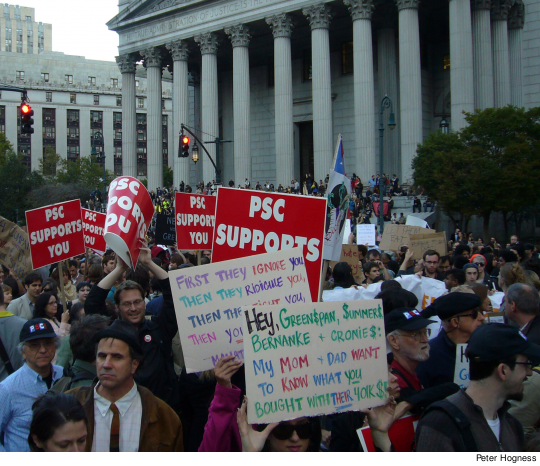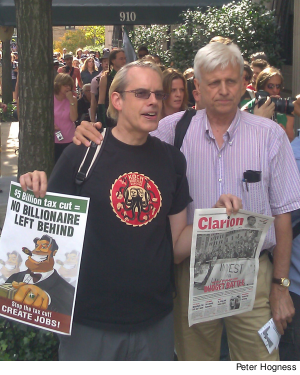 |
When a small band of protesters set up their Occupy Wall Street encampment in Zuccotti Park on September 17, few people in the labor movement noticed. But that quickly changed as the cry of “We Are the 99%!” captured the public imagination.
“They definitely seem to have figured out a way to touch a nerve that perhaps we have been less successful at doing,” said Bob Master, political director for District 1 of the Communications Workers of America. “Their boldness and creativity, their willingness to put their bodies on the line and make personal sacrifices, have been inspirational,” he told City Hall News.
In New York, local unions have responded by providing everything from rain ponchos to meeting spaces and have brought thousands of their members into the streets. It’s a rapidly evolving relationship between two groups with very different organizational cultures, both of them battered by the recession and both frustrated by policies that favor the wealthy over those who are losing their jobs and their homes.
On October 5, a massive labor-community march in support of the Occupy Wall Street (OWS) movement made clear that the hundreds of activists sleeping overnight in the park speak for many thousands more. Upwards of 20,000 protesters filled the streets of Lower Manhattan as they headed down Broadway to Zuccotti Park (which OWS has redubbed “Liberty Park,” the site’s original name). About half of those marching were union members, including several hundred from the PSC. Members of the Transit Workers, Service Employees, Communications Workers and the National Nurses’ Union also turned out in force.
“We support the Wall Street protesters and their goal to reduce inequality,” declared Transit Workers Union Local 100’s Executive Board in backing the march. “The shared sacrifice preached by government officials looks awfully like a one-way street.”
Solidarity was the theme of the October 5 march, as union members put their own demands in the context of a wider struggle. Lorriane Towns, a CUNY Research Foundation employee who works in the provost’s office at the Graduate Center, said that New York’s policies of tax cuts for the wealthy and funding cuts for CUNY and other public services must be reversed. “If we don’t get our act together, [the U.S.] is going to be like a Third World country,” said Towns. “At CUNY, we already face constant shortages.”
“It’s good to see the movement growing,” said Costas Panayotakis, an associate professor of political science at City Tech. “It’s important to dispel the pessimism that says you can’t challenge the power structure.”
STEPPING UP
Labor’s strong presence on October 5 was due in part to the work of activists from more than two dozen unions who formed a Labor Support/Outreach Committee within OWS, going back to their unions to seek political and material support for the emerging movement. Many unions stepped up in response to these appeals, while other labor leaders decided independently to get on board. “It’s become too big to ignore,” a political consultant told New York magazine. In September the PSC became the first union to back OWS, but others soon followed.
National labor groups have increasingly spoken out in support of the Occupy Wall Street protests, including the national AFL-CIO, AFT, Teamsters, Laborers, Auto Workers, Steel Workers and the public employees’ union AFSCME.
“RWDSU will do everything it can to learn from and assist Occupy Wall Street,” said Stuart Appelbaum, president of the Retail, Wholesale and Department Store Union (RWDSU). “They offer a clear perspective,” he said: “Wall Street should not control our economy, our democracy, or our lives.”
Support from thousands of union members strengthened Occupy Wall Street at a critical time – and OWS has also put wind in labor’s sails. Union protests have become larger and more energetic, drawing on both new participants and a new spirit.
 |
One case in point is the labor-supported campaign to renew New York’s “millionaires’ tax,” currently scheduled to expire at the end of this year. An Oct. 11 “March on the Millionaires’ of Park Avenue,” to spotlight the legislation, ended up far larger and livelier than its organizers had originally imagined.
PARK AVE.
After a raucous rally of more than 1,000 people from the Plaza Hotel, hundreds marched to bring the demand for taxing the rich to the doors of some of New York’s wealthiest residents. Protesters paraded past the posh penthouses of Park Avenue, with stops at the residences of News Corp. Chairman Rupert Murdoch, billionaire Tea Party financier David Koch and JPMorgan Chase CEO Jamie Dimon. The media-savvy event drew massive coverage, focusing attention on growing income inequality in New York and across the US.
“I thought today’s march was right on the money,” quipped Cecilia McCall of the PSC retirees chapter.
On October 21, hundreds of OWS supporters joined members of the Communications Workers to march on a Verizon Wireless store next to the NY Stock Exchange. They blasted Verizon for “corporate greed” in demanding $1 billion in concessions from the union despite making $22 billion in profits in the last four years.
OCCUPY VERIZON
In a sign that OWS’s militance may be contagious, they carried union-printed signs that read, “Occupy Wall Street, Occupy Verizon.” The store decided to close before they arrived.
The OWS Labor Committee has organized its own actions in support of embattled workers around the city, including 43 art handlers from Teamsters Local 814 who were locked out of their jobs at Sotheby’s auction house after refusing to accept deep contract concessions. OWS labor activists have peacefully disrupted auctions inside Sotheby’s Upper East Side headquarters and have energized the workers’ campaign to regain their jobs. The committee has also turned out support for public school aides, postal workers, and other unions fighting layoffs and giveback demands.
Labor support has been especially important to OWS as it has faced pressure from hostile City officials. When Mayor Bloomberg announced plans to evict the OWS protesters on October 14, several groups – including the PSC, TWU Local 100, SEIU 32-BJ, and the Working Families Party (WFP) – urged members to be there at 6:00 am to link arms with the occupiers. Unionists – including PSC officers and scores of PSC members – were a major part of the crowd of well over 2,000 people who were there at dawn. When word spread that the eviction had been called off, labor activists joined in the celebration. One called out, “Our movement is ‘too big to jail!’”
In Oakland, California, a police assault on the Occupy Oakland encampment was followed by a call for a one-day general strike on November 2. Many unions expressed political support and urged members to attend the day’s rallies. Though few called their members out on strike, many workers did stay off the job.
WINTER
As fall heads toward winter and harsher weather settles in, the future of the encampment at Liberty Park remains uncertain. As temperatures began to drop, a Working Families Party petition demanded that Bloomberg let the protesters set up tents, which police have previously not allowed. By late October, tents were in place across Liberty Park and for at least the first week police took no action against them.
Occupy Wall Street protesters say they are in it for the long haul – and New York unions have pledged to be there with them.
______________________________
RELATED COVERAGE:
PSC Members Assist Occupy Wall Street
Viewpoint: Four Perspectives on Occupy Wall Street
Calendar: Nov. 17 – We Are the 99% Unity Rally

